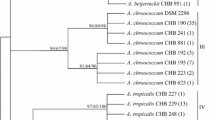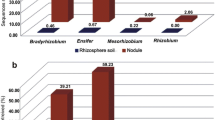Abstract
The modern agricultural practice utilizing plant growth promoting rhizobacteria (PGPR) has brought great benefits in the promotion of crop growth. Among PGPR, Azospirillum is considered as an important genus which is not only closely-associated with plants but also shows potential in the degradation of organic contaminants. However, lack of media for selective isolation or techniques for specific detection or identification limit the exploration of these rhizobacteria. This motivated us to design a genus-specific oligonucleotide primer pair which could assist in rapid detection of species of the genus Azospirillum by means of PCR-specific amplification. The sensitivity and specificity of the newly designed primer pair Azo494-F/Azo756-R were tested against 12 Azospirillum type strains and other closely-related genera. The Azospirillum-specific 16S rRNA gene fragment (263 bp) was successfully amplified for all the reference Azospirillum species with the designed primer pair. No amplification was noted for closely-related species from other genera. The genus specificity was validated with 18 strains including environmental isolates. Interestingly, two strains assigned earlier as Azospirillum amazonense (DSM 2787T) and Azospirillum irakense (DSM 11586T) failed to produce an Azospirillum-specific fragment with this primer pair. Further phylogenetic analysis of these two isolates based on 16S rRNA gene sequences shows that these two strains might belong to other genera rather than Azospirillum. Preliminary screening of isolates and soil samples with the Azospirillum-specific primers was successful in terms of the rapid detection of Azospirillum isolates. By using real-time PCR analysis the minimum limit of Azospirillum detection was 102 CFU g−1 in the seeded soil sample. The newly designed primers can be used to study the diversity of Azospirillum in ecosystems and aid in the exploration of novel species.




Similar content being viewed by others
References
Bashan Y, Holguin G, de-Bashan L (2004) Azospirillum–plant relationships: physiological, molecular, agricultural, and environmental advances (1997–2003). Can J Microbiol 50:521–577
Ben Dekhil S, Cahill M, Stackebrandt E, Sly LI (1997) Transfer of Conglomeromonas largomobilis subsp. largomobilis to the genus Azospirillum as Azospirillum largomobile comb. nov., and elevation of Conglomeromonas largomobilis subsp. parooensis to the new type species of Conglomeromonas, Conglomeromonas parooensis sp. nov. Syst Appl Microbiol 20:72–77
Eckert B, Weber OB, Kirchhof G, Halbritter A, Stoffels M, Hartmann A (2001) Azospirillum doebereinerae sp. nov., a nitrogen-fixing bacterium associated with the C(4)-grass Miscanthus. Int J Syst Evol Microbiol 51:17–26
Falk EC, Döbereiner J, Johnson JL, Krieg NR (1985) Deoxyribonucleic acid homology of Azospirillum amazonense Magalhães et al. 1984 and emendation of the description of the genus Azospirillum. Int J Syst Bacteriol 35:117–118
Hartmann A, Baldani JI (2003) The genus Azospirillum. In: Dworkin M, Falkow S, Rosenberg E, Schleifer K-H, Stackebrandt E (eds) The prokaryotes. Wiley, New York, pp 114–140
Heiner CR, Hunkapiller LK, Chen SM, Glass JI, Chen EY (1998) Sequencing multimegabase-template DNA using BigDye terminator chemistry. Genome Res 8:557–561
Helsel LO, Hollis DG, Steigerwalt AG, Levett PN (2006) Reclassification of Roseomonas fauriae Rihs et al. 1998 as a later heterotypic synonym of Azospirillum brasilense Tarrand et al. 1979. Int J Syst Evol Microbiol 56:2753–2755
Khammas KM, Ageron E, Grimont PAD, Kaiser P (1989) Azospirillum irakense sp. nov., a new nitrogen-fixing bacterium associated with rice roots and rhizosphere soil. Res Microbiol 140:679–693
Kirchhof G, Reis VM, Baldani JI, Eckert B, Doebereiner J, Hartmann A (1997) Occurrence, physiological and molecular analysis of endophytic diazotrophic bacteria in gramineous energy plants. Plant Soil 194:45–55
Lavrinenko K, Chernousova E, Gridneva E, Dubinina G, Akimov V, Kuever J, Lysenko A, Grabovich M (2010) Azospirillum thiophilum sp. nov., a novel diazotrophic bacterium isolated from a sulfide spring. Int J Syst Evol Microbiol. doi:10.1099/ijs.0.018853-0
Lin S-Y, Young C-C, Hupfer H, Siering C, Arun AB, Chen W-M, Lai W-A, Shen F-T, Rekha PD, Yassin AF (2009) Azospirillum picis sp. nov., isolated from discarded tar. Int J Syst Evol Microbiol 59:761–765
Mehnaz S, Weselowski B, Lazarovits G (2007a) Azospirillum canadense sp. nov., a nitrogen-fixing bacterium isolated from corn rhizosphere. Int J Syst Evol Microbiol 57:620–624
Mehnaz S, Weselowski B, Lazarovits G (2007b) Azospirillum zeae sp. nov., a diazotrophic bacterium isolated from rhizosphere soil of Zea mays. Int J Syst Evol Microbiol 57:2805–2809
Okon Y, Itzigsohn R (1992) Poly-β-hydroxybutyrate metabolism in Azospirillum brasilense and the ecological role of PHB in the rhizosphere. FEMS Microbiol Lett 103:131–139
Okon Y, Vanderleyden J (1997) Root-associated Azospirillum species can stimulate plants. ASM News 63:366–370
Peng G, Wang H, Zhang G, Hou W, Liu Y, Wang ET, Tan Z (2006) Azospirillum melinis sp. nov., a group of diazotrophs isolated from tropical molasses grass. Int J Syst Evol Microbiol 56:1263–1271
Reinhold B, Hurek T, Fendrik I, Pot B, Gillis M, Kersters K, Thielemans S, Ley JD (1987) Azospirillum halopraeferens sp. nov., a nitrogen-fixing organism associated with roots of kallar grass (Leptochloa fusca L. Kunth). Int J Syst Bacteriol 37:43–51
Saxena B, Modi M, Modi V (1986) Isolation and characterization of siderophores from Azospirillum lipoferum D-2. J Gen Microbiol 132:2219–2224
Seshadri S, Muthukumarasamy R, Lakshinarasimhan C, Ignacimuthu S (2000) Solubilization of inorganic phosphates by Azospirillum halopraeferans. Curr Sci 79:565–567
Shen F-T, Young C-C (2005) Rapid detection and identification of the metabolically diverse genus Gordonia by 16S rRNA-gene-targeted genus-specific primers. FEMS Microbiol Lett 250:221–227
Stahl DA, Flesher B, Mansfield HR, Montgomery L (1988) Use of phylogenetically based hybridization probes for studies of ruminal microbial ecology. Appl Environ Microbiol 54:1079–1084
Steenhoudt O, Vanderleyden J (2000) Azospirillum, a free-living nitrogen-fixing bacterium closely associated with grasses: genetic, biochemical and ecological aspects. FEMS Microbiol Rev 24:487–506
Stoffels M, Castellanos T, Hartmann A (2001) Design and application of new 16S rRNA-targeted oligonucleotide probes for the Azospirillum-Skermanella-Rhodocista-Cluster. Syst Appl Microbiol 24:83–97
Tamura K, Dudley J, Nei M, Kumar S (2007) MEGA4: molecular evolutionary genetics analysis (MEGA) software version 4.0. Mol Biol Evol 24:1596–1599
Tarrand JJ, Krieg NR, Döbereiner J (1978) A taxonomic study of the Spirillum lipoferum group, with descriptions of a new genus, Azospirillum gen. nov., and two species, Azospirillum lipoferum (Beijerinck) comb. nov. and Azospirillum brasilense sp. nov. Can J Microbiol 24:967–980
Thompson JD, Gibson TJ, Plewniak F, Jeanmougin F, Higgins DG (1997) The CLUSTAL_X windows interface: flexible strategies for multiple sequence alignment aided by quality analysis tools. Nucleic Acids Res 25:4876–4882
Thuler D, Flosh E, Handro W, Barbosa M (2003) Plant growth regulators and amino acids released by Azospirillum sp. in chemically defined medium. Lett Appl Microbiol 37:174–178
Tien TM, Gaskins MH, Hubbell DH (1979) Plant growth substances produced by Azospirillum brasilense and their effect on the growth of pearl millet (Pennisetum americanum L.). Appl Environ Microbiol 37:1016–1024
Watts D, MacBeath JR (2001) Automated fluorescent DNA sequencing on the ABI PRISM 310 Genetic Analyzer. Meth Mol Biol 167:153–170
Woese CR, Kandler O, Wheelis ML (1990) Towards a natural system of organisms: proposal for the domains Archaea, Bacteria, and Eucarya. Proc Natl Acad Sci 87:4576–4579
Xie CH, Yokota A (2005) Azospirillum oryzae sp. nov., a nitrogen-fixing bacterium isolated from the roots of the rice plant Oryza sativa. Int J Syst Evol Microbiol 55:1435–1438
Young C-C, Lin T-C, Yeh M-S, Shen F-T, Chang J-S (2005) Identification and kinetic characteristics of an indigenous diesel-degrading Gordonia alkanivorans strain. World J Microbiol Biotechnol 21:1409–1414
Young C-C, Hupfer H, Siering C, Ho M-J, Arun AB, Lai W-A, Rekha PD, Shen F-T, Hung M-H, Chen W-M, Yassin AF (2008) Azospirillum rugosum sp. nov., isolated from oil-contaminated soil. Int J Syst Evol Microbiol 58:959–963
Zhou Y, Wei W, Wang X, Xu L, Lai R (2009) Azospirillum palatum sp. nov., isolated from forest soil in Zhejiang province, China. J Gen Appl Microbiol 55:1–7
Acknowledgments
This research work was kindly supported by grants from National Science Council, Council of Agriculture, Executive Yuan and in part by the Ministry of Education, Taiwan, R.O.C under the ATU plan.
Author information
Authors and Affiliations
Corresponding author
Electronic supplementary material
Below is the link to the electronic supplementary material.
Rights and permissions
About this article
Cite this article
Lin, SY., Shen, FT. & Young, CC. Rapid detection and identification of the free-living nitrogen fixing genus Azospirillum by 16S rRNA-gene-targeted genus-specific primers. Antonie van Leeuwenhoek 99, 837–844 (2011). https://doi.org/10.1007/s10482-011-9558-1
Received:
Accepted:
Published:
Issue Date:
DOI: https://doi.org/10.1007/s10482-011-9558-1




